Payload
An ESA study carried out by the Concurrent Design Facility (CDF) at ESA's Space Research and Technology Centre (ESTEC) in July 2011 provided a reference design for the EChO telescope and spectrometer. Since then, designs have been studied by Industry and by the instrument consortium respectively.
Telescope
The baseline telescope design is an afocal, off-axis, Korsch-like system with a 1-m class diameter elliptical primary. The configuration was selected from a number of designs using trade-off parameters that included photometric stability, complexity, baffling and straylight control, manufacturability, ease of verification/test/calibration, flexibility and cost. The selected design consists of three conic mirrors used off-axis in an afocal configuration, but with an intermediate focus between the secondary and tertiary mirrors. Folding mirrors are included to facilitate accommodation of the instrument and could be used to accommodate a fine-steering tip-tilt mechanism if needed.
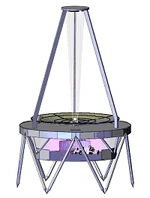 |
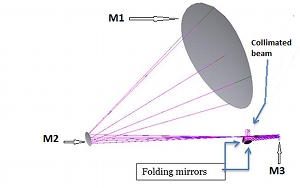 |
|
A 3-D view of the CDF reference telescope. Credit: ESA |
The current 3 mirror off-axis reference telescope. Credit: ESA |
EChO spectrometer
ECHO will cover the 0.55 – 11 micron waveband (goal to extend to 0.4 -16 microns) with continuous and simultaneous spectral coverage that is unique among current and proposed facilities for transit spectroscopy studies.
This broad spectral coverage gives access to an extensive range of spectral features from many key molecules that can be used to study the atmospheres of exoplanets covering a range of masses and physical temperatures. Crucially, with coverage in the optical as well as in the near- and thermal-infrared it will be possible to distinguish between small variations in the combined signal of the host star and exoplanet and those due to variations in the output of the host star.
The waveband will be split into a number of distinct channels using a series of dichroics, with the goal to achieve a sensitivity that is limited only by astronomical noise (i.e. photon noise from the host star and zodiacal light) in each of the channels using appropriate detector technology. A resolving power of R~300 or better will be required at wavelengths below 5 microns and R~30 (goal R~300) for wavelengths above.
The proposed payload has a modular design with self-contained units and detector systems for each of the wavelength channels. A consistent design philosophy has been implemented throughout the study process to ensure the production of a robust and efficient instrument; thus all optical designs are kept simple with the minimal number of components and without any mechanisms. All reflective optical elements, module structures and the Instrument Optical Bench are to be manufactured from Aluminium to ensure components have a matched CTE (coefficient of thermal expansion), allowing warm alignment of the instrument to be undertaken whilst ensuring little deviation in relative position on cooling. Transmissive optical components such as dichroics and lenses will be mounted so as to minimise any imposed distortions under cooling – this will use existing design approaches with proven heritage from an extensive history of space infrared instruments built by the consortium partners.
A set of input optics mounted on the Instrument Optical Bench (IOB) incorporates five dichroics for spectral division. The first dichroic (D1) directs shortwave light towards the Fine Guidance Sensor (FGS) and Visible and Near-InfraRed (VNIR) channel. A beamsplitter takes a fraction of this light to the FGS while optical fibres channel the remaining light to the cross-dispersed spectrometer of the VNIR module.
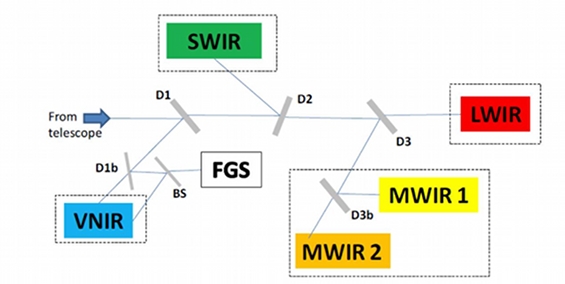 |
|
Baseline concept for the separation of spectral channels. Credit: EChO Instrument Consortium |
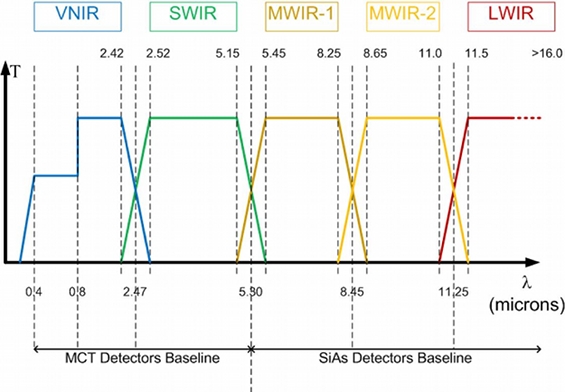 |
|
Channel nomenclature and wavelength division points. Credit: EChO Instrument Consortium |
Further dichroics divide the remaining light through the grating-based dispersive spectrometer of the ShortWave InfraRed (SWIR) module, the prism-based dispersive spectrometers of the MidWave InfraRed (MWIR) module, and the prism-based dispersive spectrometer for the LongWave InfraRed (LWIR) module.
There will be on-board calibration sources to allow in-flight calibration and characterization of the modules throughout the mission life. The fold mirror after the first dichroic element has a small central aperture to allow for exposure to the internal infrared calibration source, which consists of an integrating sphere with thermal broadband sources. An overview of the mechanical configuration is given in the figure below.
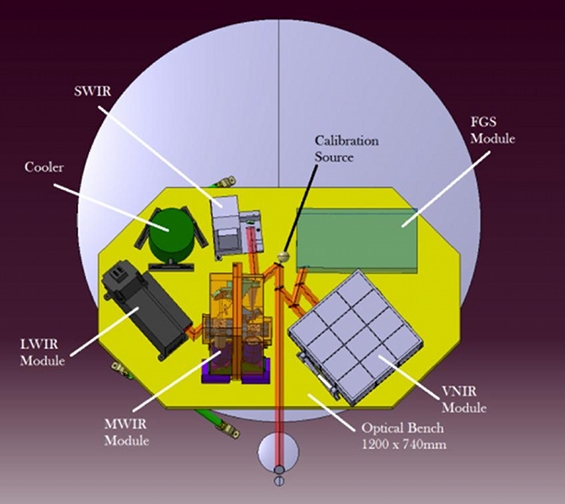 |
|
Diagram of EChO optical bench and telescope arrangement (instrument radiator and stray-light cover removed for clarity). Credit: EChO Instrument Consortium |
The EChO payload electrical architecture is designed to simplify the interfaces between the instrument system and the spacecraft. A data processing unit (DPU) will control all instrument detector signal acquisition, processing and instrument control functions.
The baseline detector system involves a separate detector unit and signal chain for each module.
Mercury cadmium telluride (MCT) detectors are baselined to all modules: European provided detectors operating on passively cooled stage at 45K for the VNIR and SWIR channels; Teledyne MCTs for the MWIR channel operating at ~ 35K, with a goal of MCT detectors operating beyond 11 micron at 35K for the LWIR.
The MIR (and LWIR) detectors are cooled by a single stage Neon Joule Thomson active cooler, which utilises the passive radiator from the spacecraft for the necessary pre-cooling.
All detectors will be coupled with low-power dissipation cold electronics, providing detector control and analogue-to-digital conversion. This limits the electromagnetic compatibility (EMC) pick-up and thermal leaks from the warm to cold harnessing.
